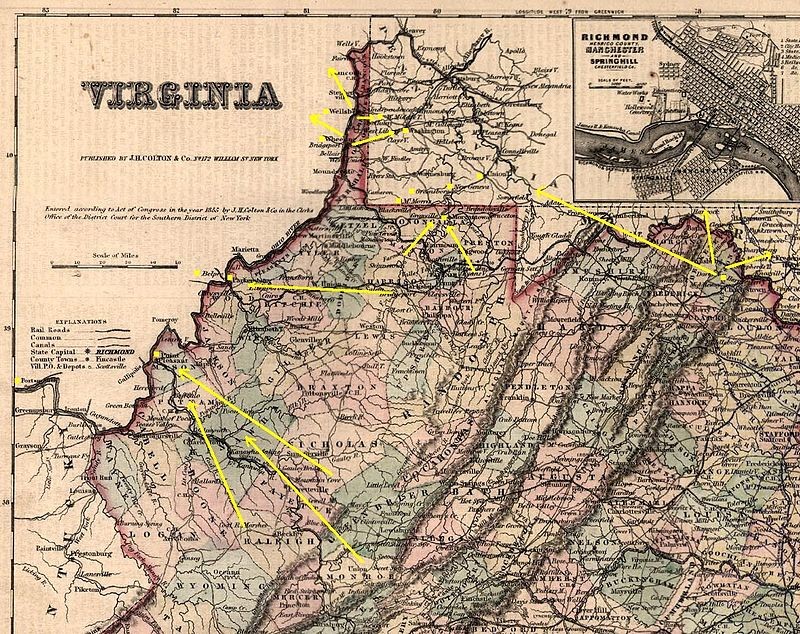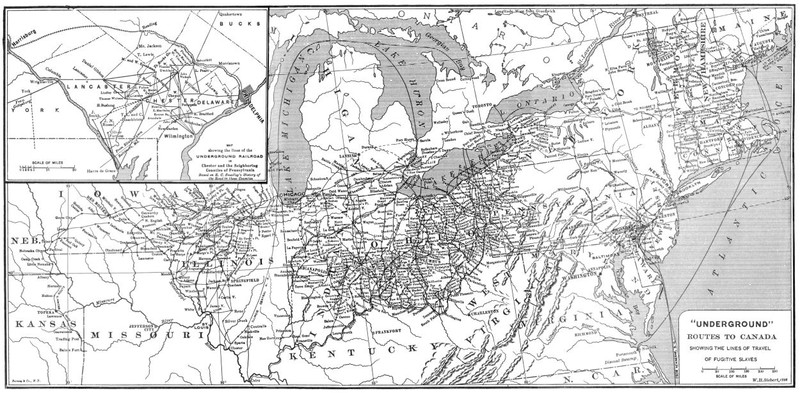Nutter Farm
Introduction
Text-to-speech Audio
Images
Map of Underground Railroad routes through western Virginia.

Map of Underground Railroad routes across the United States.

Backstory and Context
Text-to-speech Audio
The Nutter family that arrived in western Virginia from England during the colonial period originally consisted of four brothers: Isaac, Levi, John, and Thomas. At the time, the area of western Virginia they settled in was part of Harrison County near Addis’ Run. Within a few years, however, the four brothers had gone their separate ways to spread out across the area and migrate farther west. Isaac made the first settlement in what is now Rusk, Ritchie County before moving on to Gillispie’s Run and later Indiana. John moved to what became Cairo in Ritchie County, then Richardson in Calhoun. Thomas moved from Cairo to Athens County. Levi, meanwhile, set up shop on a thousand acres of land near Goose Creek in an area that eventually came to be known as Nutter Farm.
When Levi and his wife Margaret Webb arrived to what became Nutter Farm they already had one son, one cow, one calf, and one horse. The Nutters regularly visited Levi’s brother Isaac seven miles away prior to his departure from the area. Isaac lived seven miles from Levi and his family and during these trips Levi rode on horseback carrying the calf with cow and Margaret following behind him carrying Thomas. This protected their small flock and family from predators and thieves while they were absent from their home. The flock and family were not small for long, however. Soon, the Nutters had a daughter, five more sons, a “mansion,” and a bustling farm. According to Levi’s will written in 1850, the Nutters achieved this growth without the aid of enslaved labor. This appears to be relatively common for the area. The slave schedule in the 1860 census for Ritchie County only lists a dozen slaveholders out of a population of 6,847, none of whom owned more than eight slaves.
What makes the Nutters unique, however, is that modern historians now believe they may have been active as conductors on the Underground Railroad. According to research by Henry Robert Burke and Sandra Moats, runaway slaves hid on the Nutters’ land on their way to freedom in Ohio via Parkersburg. These slaves would travel via the Northwestern Turnpike (now US 50) before continuing up Marietta Run Road and then down Bull Creek to the Ohio River. Because the Northwestern Turnpike ran through the Nutters land, their farm was an ideal stopping point for travelers on the Underground Railroad. Burke and Moats further theorize that the untimely ends of Thomas, William, Matthew, and Jonas “Tone” Nutter from 1852 to 1862 may have been related to the aid they possibly gave to runaway slaves. Thomas died the year after his father, gunned down by a Deputy Lowther while (according to family reports) he was unarmed and manacled. Jonas died sometime after being released on bail in 1854 for an undisclosed crime, hit over the head with a sled in the dark. William was killed in 1856 after a man named Henry Reece threw a rock and hit him in the head while he was riding on horseback down Myers Fork Ford. William fell off his horse but managed to climb back on and escape to refuge with Thomas’ widow Deborah, who nursed him until his death shortly thereafter. Matthew, meanwhile, died in 1862 under mysterious ends that family records describe only as a “violent death.” Prior to these deaths, the brothers ran into frequent trouble with the pro-slavery prosecuting attorney of Ritchie County, Cyrus Hall, who charged the Nutters with a bevy of crimes ranging from larceny to racing, all charges leveled at participants in the Underground Railroad for “stealing” slaves and speeding between stations in the regional anti-slavery network.
Burke and Moats also suggest that the Nutters may have had an association with Doddridge County’s Luke Jaco, another purported conductor on the Underground Railroad whose sister lived three miles from the Nutters and who was buried in Terry Cemetery near their land. Like Jaco, however, the Nutters connection to the Underground Railroad is somewhat suppositional. While, unlike Jaco, the Nutters appear not to have owned any slaves, that does not demonstrate with any certainty that they were opposed to the institution. Many western Virginians did not own slaves in the antebellum period and yet benefited from the institution of slavery in a variety of ways. Moreover, while the close proximity of the Nutter brothers’ deaths does merit suspicion, it does not mean they suffered retaliation at the hands of slaveowners or their supporters. It could simply be that the Nutters had frequent conflicts with their neighbors and suffered consequences as a result. The Nutters may well be yet another white family whose apparent participation in the Underground Railroad is more a result of mythmaking than fact. Regardless, their lives and fates are an indication of the often-violent nature of life in western Virginia in the late antebellum period and Civil War. If they were, in fact, conductors on the Underground Railroad, their fates are symbolic of the real danger anti-slavery activists placed themselves in to undermine the institution of slavery.
Cite This Entry
Wuertenberg, Nathan. "Nutter Farm." Clio: Your Guide to History. December 31, 2019. Accessed March 14, 2025. https://theclio.com/tour/1083/3
Sources
“1860 Slave Schedule for Ritchie County.” The USGenWeb Census Project®. Accessed December 31, 2019. http://us-census.org/pub/usgenweb/census/wv/ritchie/1860/slave.txt.
Burke, Sandra Moats. “Nutter Brothers and UGR.” Afrigeneas, April 30, 2006. https://www.afrigeneas.com/forum-ugrr/index.cgi/md/read/id/657/sbj/nutter-brothers-and-ugr/.
Burke, Sandra Moats. “Nutter Murders in West Virginia.” Genealogy.com, July 15, 2000. https://www.genealogy.com/forum/surnames/topics/nutter/315/.
Burke, Sandra Moats. “Quilts Plus UGRR in West Virginia.” Afrigeneas.com (blog), January 26, 2005. http://www.afrigeneas.com/forum-ugrr/index.cgi/md/read/id/473/sbj/quilts-plus-ugrr-in-west-virginia/.
“Killed.” Cooper's Clarksburg Register, December 22, 1852.
Lowther, Minnie Kendall. History of Ritchie County. Salem, MA: Higginson Book Co., 1911.
Watts, Cornelius C. Reports of Cases Argued and Determined in the Supreme Court of Appeals of West Virginia. Vol. 21. Charleston: B.J.W. Printers, 1901.
Wikipedia
Project Gutenberg
